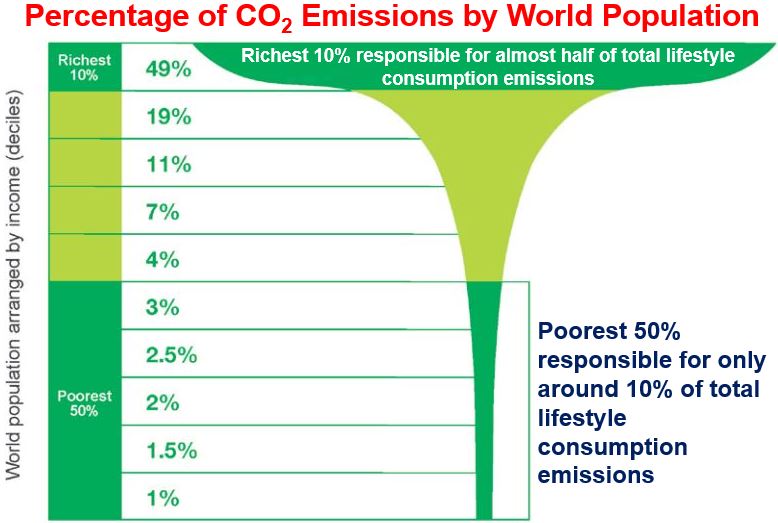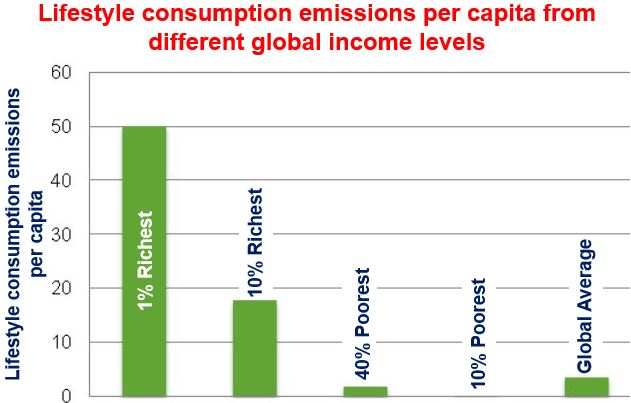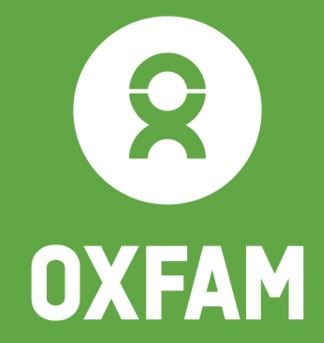The world’s richest 10% produce about half of all carbon emissions, while the poorest 3.5 billion people account for only one tenth of all carbon emissions, says a new Oxfam report. Ironically, the 10% richest will be the least affected by the consequences of climate change, while the 3.5 billion poorest will be the most threatened.
The new Oxfam report – ‘Extreme Carbon Inequality’ – released during the 2015 United Nations Climate Change Conference, which is currently underway in Paris, provides new estimates of the lifestyle consumption emissions of poor and rich citizens in different nations.
While the representatives of about 180 countries work towards an agreement based on total emissions produced by their respective nations, this report helps put to bed a myth that the citizens of rapidly emerging economies are most to blame for global warming.
 This image shows the distribution of global income from the richest to poorest 10% of people globally, and Oxfam’s estimate of their associated lifestyle consumption emissions as a share of the worldwide total. (Source: Oxfam Report)
This image shows the distribution of global income from the richest to poorest 10% of people globally, and Oxfam’s estimate of their associated lifestyle consumption emissions as a share of the worldwide total. (Source: Oxfam Report)
Emissions per person in poor nations comparatively very low
Greenhouse gas emissions are growing fastest in developing economies. However, much of it is for the production of goods consumed in other nations. This means that the emissions linked to the lifestyle of most citizens in developing countries is still considerably lower than their counterparts in the rich countries.
Report author, Tim Gore, who is head of food and climate policy at Oxfam, said:
“Climate change and economic inequality are inextricably linked and together pose one of the greatest challenges of the 21st century.”
“Paris must be the start of building a more human economy for all – not just for the ‘haves,’ the richest and highest emitters, but also the ‘have-nots,’ the poorest people who are the least responsible for and most vulnerable to climate change.”
 The difference between the 1% richest and 10% poorest is enormous. (Source: Oxfam Report)
The difference between the 1% richest and 10% poorest is enormous. (Source: Oxfam Report)
Inequality in emissions responsibility
Mr. Gore said his report clearly shows the extent of this inequality in emissions responsibility – within nations, between then and globally. For example:
– A person in the richest 1% of the world’s population on average uses 175 times more carbon compared to an individual from the bottom 10%.
– A citizen in India in the richest 10% of people in his or her country uses, on average, only one quarter of the carbon that an individual in the poorest half of the population of the US.
– The average emissions of an individual in the poorest half of the Indian population uses just one-twentieth of that used by a person in the poorest half of the population of the United States.
– The total emissions of the richest 10% of the US population, about 30 million people, are three times greater than the total emissions of the poorest half of China, around 600 million people.
 Most of the world’s richest 10% high emitters still live in wealthy OECD countries, although that is slowly changing. (Source: Oxfam Report)
Most of the world’s richest 10% high emitters still live in wealthy OECD countries, although that is slowly changing. (Source: Oxfam Report)
High emitters should be made accountable
Mr. Gore said:
“Rich, high emitters should be held accountable for their emissions, no matter where they live. But it’s easy to forget that rapidly developing economies are also home to the majority of the world’s very poorest people and while they have to do their fair share, it is rich countries that should still lead the way.”
The report points out that the only people who benefit from the current status quo, and stand to gain if no effective agreement is reached in Paris, is a ‘select group of billionaires’, whose fortunes in many cases were made in the fossil fuel industry.
Fossils fuels are fuels formed by natural processes, such as the decomposition of buried dead organisms over hundreds of millions of years. They contain high percentages of carbon and include natural gas, petroleum and coal.
Tackling the economic inequality that these so-called ‘carbon barons’ thrive on is crucial both to fighting climate change and ending extreme poverty, the author believes.
Poorest people are the most vulnerable
According to a recent World Bank report, the poorest people in the world are generally the most vulnerable and least prepared to cope and overcome the effects of climate change, regardless of national borders.
Women, especially those living in rural communities, are most at risk, because they depend on agriculture and have few other opportunities to earn a living.
Mr. Gore continued:
“Extreme carbon inequality has to be capped. Any deal must keep alive the possibility of holding global warming at 1.5 degrees Celsius, and provide a major boost in funding to help the poorest and most vulnerable communities adapt to climate change.”
Oxfam is urging those involved in negotiating a deal in Paris to include some way of addressing the loss and damage from the effects of climate change when it is not possible to adapt. It is also urging them to make sure that all climate projects and actions respect general equality and human rights.

